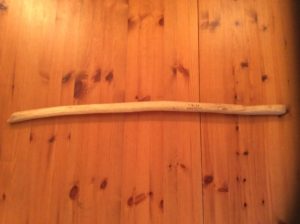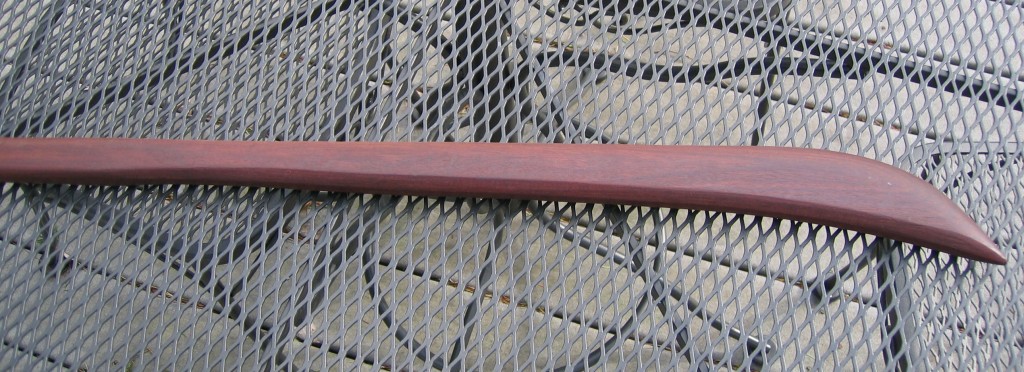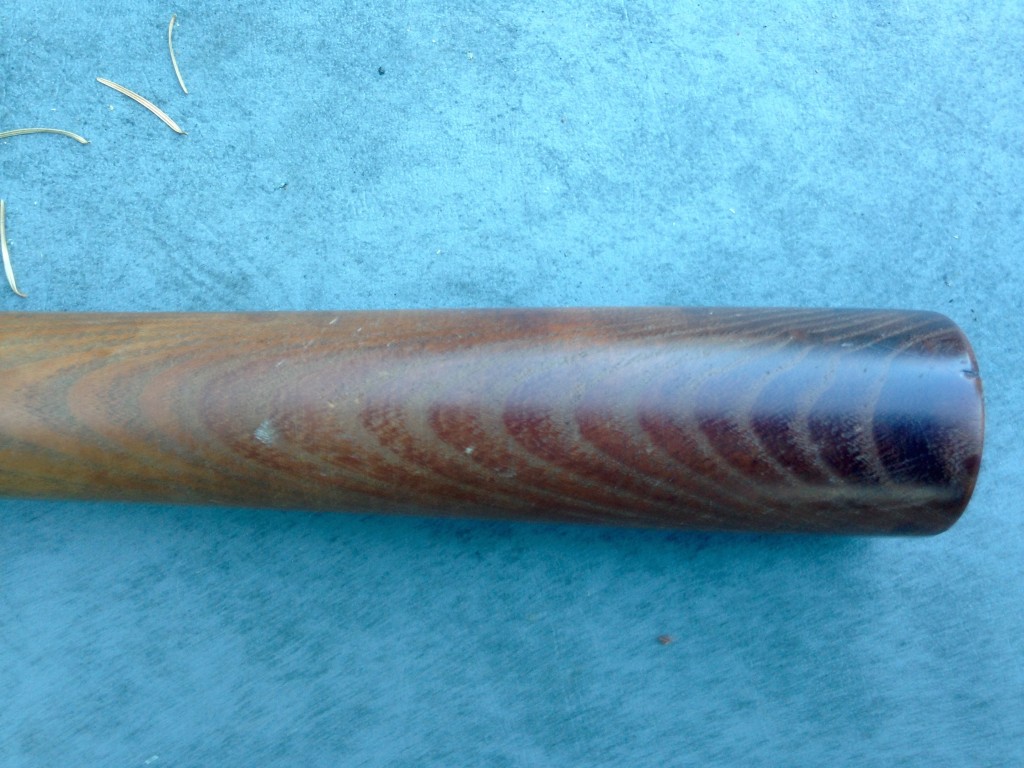Everyone of these woods can be used for impact weapons training, but each has one or more limitations that make them less than ideal.
African Plum (Pygeum africanum, a.k.a. Prunus Africana) – This evergreen tree is known as Red Stinkwood, Pygeum, African Plum, African Cherry, and of course, Ironwood. The wood is reported to have a pungent odor. The European bokken company, Koryu Bokken (sadly, no longer doing business), praised this pinkish wood highly, both for its “flame” patterning and it’s strength and hardness. However, it is not notably dent resistant. The bark has achieved notice as an herbal with a number of beneficial properties and the tree is becoming increasingly endangered in some areas, albeit secure in others. In any event, do not buy weaponry from this wood unless you can get assurances that it is the product of managed, sound harvesting practices.
- Bending strength – 15,983 psi
- Maximum Crushing strength – 8510 psi
- Shearing strength – 2404 psi
- Static bending – 7840 psi
- Janka Hardness Scale 1955
Blackthorn (Prunus Spinosa) – This variety of plum (sloe berry) is a medium sized shrub. The wood was used to make cudgels in England and Ireland, the latter famously known as shillelagh. The wood is very tough, and because it is so twisty, it made for great looking walking sticks. The grip end of such a walking stick was often a root-knob. The Irish also used shillelagh of oak, crab-apple, holly, or hawthorne as weapons of self-defense and combat. A practitioner of An Maide Bata, writes: “I have had my blackthorn shillelagh for three years now for high impact training against various woods and it doesn’t even have a nick. I heard it is considered the wood with the best lightness/solidity ratio. It would be very tricky to find a suitable piece for a bokken (although Jigen Ryu guys would probably find it to their liking), I believe a jo or even a bo wouldn’t be very problematic though. I have seen some very long and straight shillelagh” In short, the wood seems to have wonderful qualities, but one will not find something to fabricate into a Japanese practice weapon. Janka Hardness Scale – NOTE: I have not been able to find a Janka rating (or other information anywhere, but in various websites, the wood is described as similar to osage orange, and several other hard/flexible woods).
Hawthorn [English] (Crataegus laevigatus) – A hard tough wood from a shrub/tree related to the rose family, it grows in very twisted shapes. Hawthorne and oak were once the preferred woods for the English quarterstaff. It was used in Ireland for tool handles and mallet heads. Laurence Angier (located in Northwest England) writes: “Hawthorn bokkens have a weight similar to that of a hickory bokken. They will dent a red oak bokken without any scratch but after heavy combat they will dent against a hickory bokken. . . I have found that by using a sapling you do not have to worry about grain orientation as you ‘carve the weapon out of the log with the growth rings providing strength in every direction as well as uniform shrinking leading to no warping and bowing.”
Janka Hardness Scale ????
Ipe (Tabebuia serratifolia) (It is also called Pau d’Arco, Lapacho, Poui, Greenheart [also the name of a very different tree] and for commercial purposes, Brazilian Walnut) – this South American wood is one of many called ironwood. It seems to come in variety of colors. The ones I have a maroon cast. I’ve seen other samples that are chocolate, with light speckles. Ipe is a very hard and very heavy wood, and it is being used to make wooden weapons in Brazil, in the United States and elsewhere. I’ve had a number of naginata made of out this wood. I do not like it, however. It has a particular quality that can only be termed dead – only one of the more than eight weapons I’ve had made have any life to it. Force is transferred through the weapon back into the hands with a peculiar leaden feel. Worse, although it is very hard to break, the grain lifts up in a feather of splinters and if you run your fingers along the weapon or if it slides on the opponent’s body, those splinters go deep and break off. The wood fibers individually fray, so that these splinters are very hard to get back out of your flesh. I’ll not use it for weaponry again. If you do decide to use ipe, it is somewhat endangered. Check if the wood comes from cultivated trees – harvesting in the wild of this slow-growing tree terribly damages large stretches of forest. This shouldn’t be a problem however; cultivated ipe is used in decking, and thus, long planks are easy to come by. One added report I’ve received from someone who has used ipe bokuto: “Torsional stresses do incredible damage. Each time I have broken a bokuto (tacho or kodachi), it was through nagashi/nagareru techniques that impart a massive twisting moment.”
- Bending strength – 25,963 psi
- Maximum Crushing strength – 13,366 psi
- Shearing strength – 2048 psi
- Work to Maximum Load – 22 in-lbs./in3
- Janka hardness scale – 3684
Osage-orange – Reports I’ve received state that weapons feel exceptionally alive. One account I’ve read states that with long weapons, it absorbs energy with a very springy feel. Tobin Threadgill, of the Takamura-ha Shindo Yoshin-ryu writes: “I recently acquired a Orange Osage TSYR bokken from Beth Johnson. It is a fantastic weapon, balanced, durable, shock resistant and alive in the hand. It must be stated that she took great care to obtain a plank of Orange Osage worthy of the task, and that’s the problem with Orange Osage. Finding a plank for a bokken is difficult as it is rarely suitable due to the extreme nature of the grain structure. It takes a discerning eye to find an appropriate plank but when appropriately selected the stuff is fantastic.” One informant tells me that “the feel of Osage Orange feels quite similar to that of a Kingfisher Appalachian Hickory bokken,” which is one of the benchmarks of fine wood weapons. “In terms of impact, Osage Orange also feels ‘alive.’ Upon contact, the bokken rings but the vibrational impact seems subdued when it reaches the hands. To make a vague comparison. The feel of impact is almost the same as the type of impact you would feel if you put your hands on the sides of a Japanese drum when hit. You can see there is some strong impact, yet you don’t really feel the entirety of it. All the while, the grip on the Osage Orange remains firm. That’s why it feels alive: the forces transmitted are succinct and sensitive to your hands, yet the impact is well-taken.” Janka hardness 2320
Purpleheart (Peltogyne paniculata) – This is a hard wood to work, but it is dense, flexible and hard. I’ve got a very nice bokuto out of this wood. It dents too much, but I’m not concerned about it breaking without some very hard impact. The color is very flamboyant, but it will darken with age to a dark brown. I find the wood – overall – a little light to the hands. It is quite stiff, and rather than absorbing, transmits the force back towards the impact and also into the hands. I do not like the feel – it seems to “resist.” It feels like it fights one’s own hands as it impacts another weapon. Purpleheart tends, like oak, to dry out over time. Keep it well oiled. One caution I have received regarding purpleheart: “It grenades when it breaks and shoots little pellet-like fragments. Not fun when they pepper your eyes.” Another bokken maker informed me, however, that if you “burnish” the surface of the wood, crushing the outer surface with a hard object, you could mitigate the denting.
- Bending strength – 22,195 psi
- Maximum Crushing strength – 12,093 psi
- Shearing strength – 2176 psi
- Static bending – 12, 515
- Toughness – 271 in-lbs.
- Work to Maximum Load – 20 in-lbs./in3
- Janka Hardness Scale – 2430


